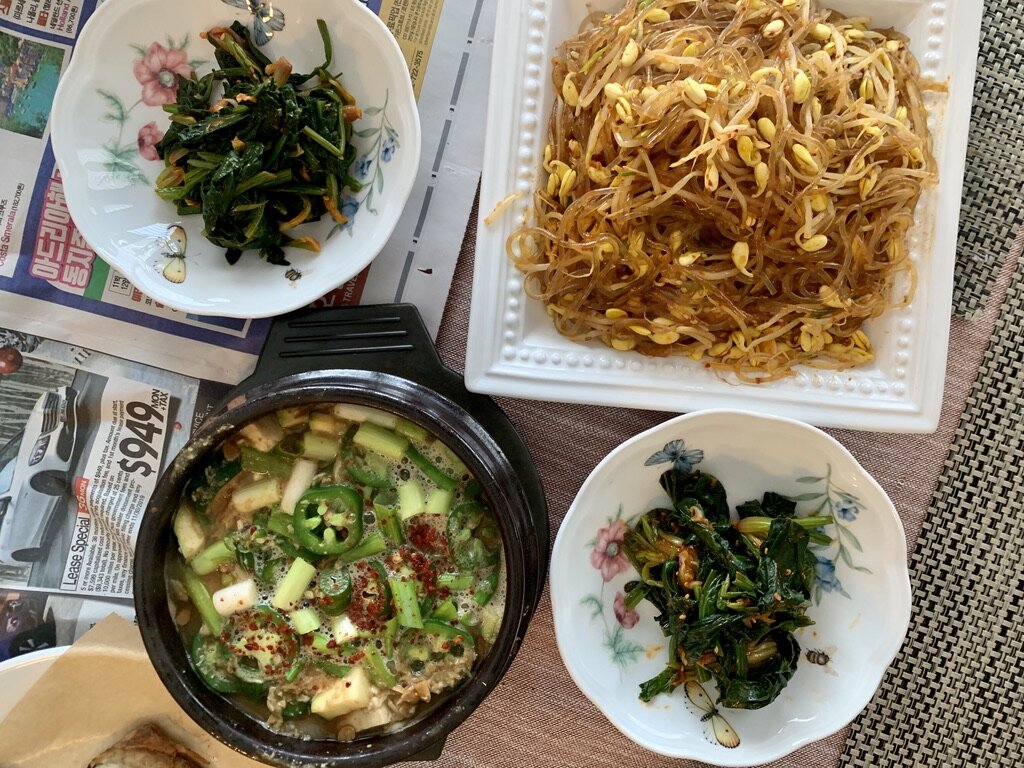Our Taste of Home: Son-mat
By Stella Chung
"Alright, so when do you put the tofu in?" I ask.
"I don't know... People just put it in whenever!" my mom responds.
"But I'm not asking about people. I want to know when you put the tofu in?" I ask again.
My mom and I yell at each other over the phone for a few more minutes until she finally gives in and says that the tofu for the 된장 찌개 (doenjang-jjigae) should go in after the broth starts boiling. You might think it's silly of me to be hung up on something like knowing the exact order in which the ingredients need to enter the pot, but I think it's important—it's the way my mom does it, which means it’s the way my grandmother and great-grandmother did it and all the women before them. If you look up recipes for doenjang-jjigae on Youtube, you'll find tons of variations. Some people put vegetables first, soybean paste last. Others put tofu in last, soybean paste first. One person's broth might look thick and opaque, while another person might prefer a different water to soybean paste ratio.
Homemade meal by Stella’s mom. 된장 찌개 (doenjang-jjigae) in the bottom left corner. Soybean sprout noodles 콩나물 잡채 (kongnamul japchae) in the top right corner.
Photo courtesy of Julie Chung.
When we talk about Korean cooking, you'll often hear about 손맛 (son-mat) which literally means "hand taste." It often refers to mothers and the unique flavor that comes from the labor and love of the person making the food. Son-mat is also genealogical. As we watch the labor our mothers put into their dishes, we acquire son-mat, and we put that same love and care into the dishes we make for our loved ones.
When I lived in Korea for a year, I indulged in some of the best restaurants around the country, but still, nothing quite matched my mom's son-mat. In 2018, my mom and sister came to see me in Korea—nearly 14 years after their last visit. It was strange yet comforting as relatives we hadn't seen in years welcomed and greeted us like time had barely passed at all. During a visit to my mom's oldest sister's house, we decided we should just stay home and enjoy 집밥 (jipbap), meaning a home-cooked meal. As we sat down to enjoy the freshly made 열무 김치 (yeolmu kimchi) and doenjang-jjigae that my aunt and mom had made together, I took a spoonful of the broth and I was in awe. It tasted perfect, just like home—it was their son-mat!
Homemade meal by Stella’s aunt in Korea.
Photo courtesy of Stella Chung.
Homemade meal by Stella’s aunt in Korea.
Photo courtesy of Stella Chung.
I visited my aunt again in 2019. As usual, she insisted on preparing jipbap rather than wasting money on food she could easily make at home. I watched her pour sesame oil into the bowl with one hand as she mixed the soybean sprouts with the other for her 콩나물 무침 (kongnamul muchim). She told me to open wide as she dropped some of the marinated bean sprouts into my mouth. I almost shed a tear as I tasted it. It tasted just like my mom's. They are sisters, thousands of miles apart from one another, yet their food tasted exactly the same. It was my mom's son-mat, my aunt's son-mat, and my grandmother's son-mat all mixed into one dish.
I can't attest to whether or not the order of ingredients has any effect on the son-mat of a dish, but I learn these little, seemingly trivial details to honor my roots and the knowledge and labor of my ancestors. These are the roots that can so easily be forgotten and lost for descendants of immigrants, like me. As a diasporic Korean, physically removed from the land of my relatives and ancestors, it can be difficult to take part in this collective ritual and sharing of knowledge. But when I taste my mom's food, I remember that I can continue my family's culture of food and care through son-mat.





